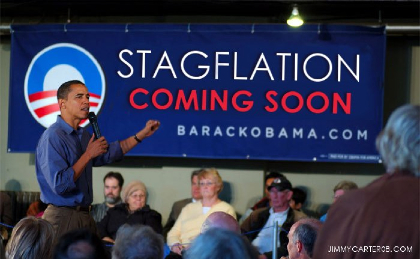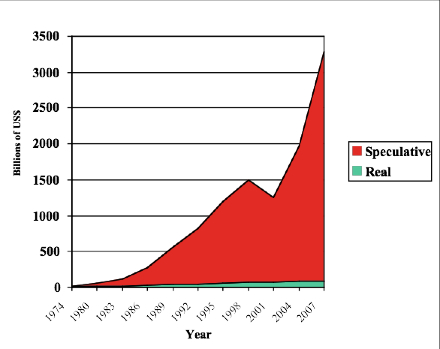A Word You Should Know: "Stagflation"
January 25, 2011
 By Anthony Migchels
By Anthony Migchels(for henrymakow.com)
Since the start of the Credit Crunch in Sept. 2008, a fierce debate has raged over whether we will face deflation or inflation. We can now conclude we will have a toxic combination of both, known as stagflation.
Stagflation is the phenomenon of rising prices and falling demand and production. It was first experienced in the late seventies and although it eventually disappeared, there was never a good explanation for it.
Proponents of both sides of the aforementioned debate had strong arguments.
Deflationists said the banks were insolvent and would not be able to provide credit, leading to a diminishing money supply and declining prices.
Inflationists said Central Banking and Governmental policies of bail outs, QE1,2,x and stimulus would lead to more money in circulation, with rising prices as a result.
Both were right, but they missed a crucial point. There are two economies. One is the real economy, where you and I operate. We work and make stuff. Cars, food, all sorts of services.
And there is also the financial economy. This is the shadowy world of finance, FOREX, stock exchanges, commodity exchanges. The graph below shows the vast scale of this financial economy, which is many times bigger than the real economy.
 Graph by Margrit Kennedy and Bernard Lietaer, based on BIS figures
Graph by Margrit Kennedy and Bernard Lietaer, based on BIS figuresThe transaction volume for the financial economy is in red and the real economy is in green. At this point we are talking about 5 trillion worth of transactions per day in the financial economy, many times more than in the real economy. We can also see that while the real economy grows in linear fashion, the financial economy grows exponentially. The unexpected decline we see around 2000 is explained by the introduction of the euro, which diminished FOREX speculation. A small price to pay for that giant leap towards World Currency.
It also shows that the financial sector began only in the early seventies. This is explained by the rise of the computer. Most people don't realize that even in the early sixties, most wages were paid weekly.....in cash. It is the computer that made it possible for banks to connect everybody to their system. It also explains why stagflation had not been around before the late seventies.
The financial and real economies to some extent interact, primarily via commodity exchanges. But the financial economy is largely isolated. Most of the hot money never reaches the real economy.
Thankfully, otherwise the dollar wouldn't even be worth the 1% of its 1913 purchasing power it has now. This is so, because for instance, FOREX is just an eternal ping pong of transactions within the banking sector, leading to an eternal wealth transfer from the not-so-savvy to the "usual suspects."
The two parallel economies also explain why price rises have not kept up with the expansion of credit. A lot of the newly created money was siphoned off to the financial economy.
We have a deflation in the real economy but a massive inflation in the financial economy. Stagflation is coming because a portion of this hot money is now entering the commodity markets, leading to inflation in the primary sector (agriculture and mining). These rising prices will be passed on by producers in the secondary and tertiary sectors (industry and services.)
An example of this process were the skyrocketing oil prices in 2009. It has been established that Goldman Sachs was using TAARP funds to drive up prices.
Another example is the current rise in food prices. Or what do we think of JPM cornering the copper market?
The deflation in the real economy is caused by the credit crunch, and by the new Capital Reserve Requirements that were foisted upon the banking system by the Bank of International Settlements.
Meanwhile corporations are choked by lack of credit and going out of production, resulting in rising unemployment.
So what does the future look like? We will be facing rising prices while the economy will be depressed, i.e. declining production and high levels of unemployment. This will result in volatility in the commodity markets, something we are now seeing with commodity stocks correcting by as much as one third.
I would like to express my appreciation for Dick Eastman's courageous and groundbreaking thoughts on the parallel economies and its implications.
Anthony Migchels' Website
---
Financial Times on Stagflation
The Guardian on Stagflation







Arthur said (January 26, 2011):
Thanks for the excellent explanation. A large majority of Americans lack the intelligence, courage and morality to understand what is going on in the USA. I think we are headed for failure. The "culture" is fragmented and degraded and tolerance and diversity are the new norm. I also think the strong informed citizens will survive and those with self imposed stupidity will get the screwing they deserve. Nobody forced them to be stupid.